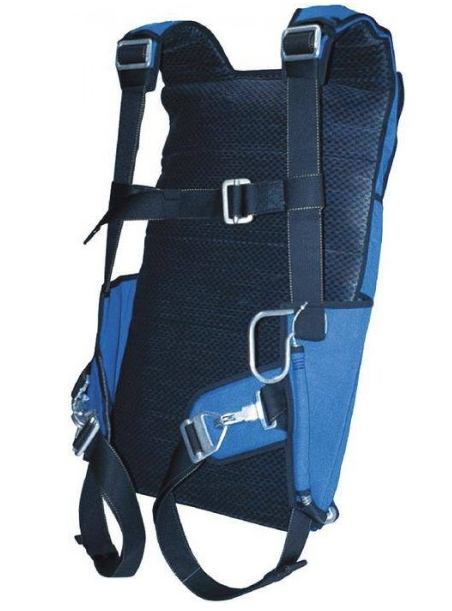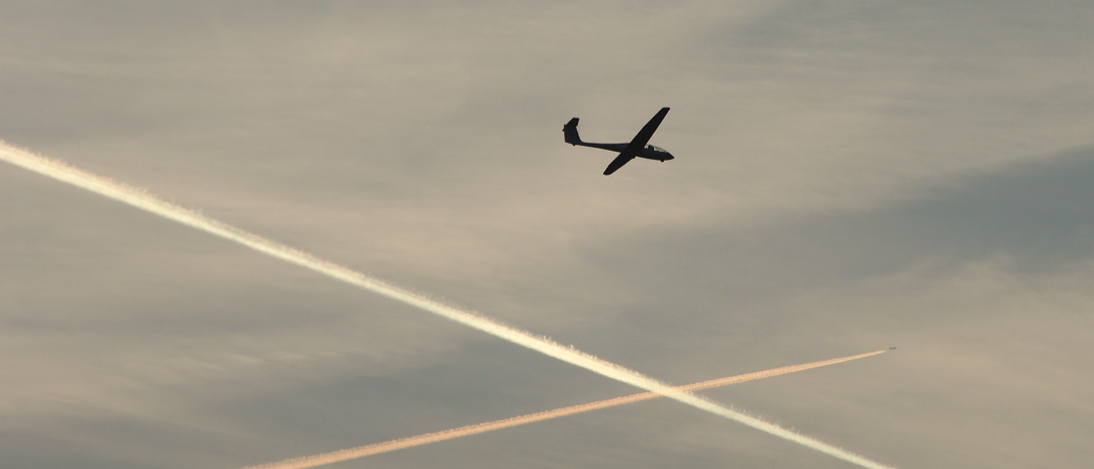4. LESSON 1 - FIRST FLIGHT
KEY POINTS
- Your pilot will prepare for this flight with care
- The most important thing each of you will be doing is looking out for other aircraft
FIRST FLIGHT
Your introductory flight is one you will always remember, here you will experience what it’s like to fly in a glider. If your pilot is also an instructor, you might get the opportunity to control the glider yourself.
PARACHUTES
It is quite normal for glider pilots to fly with a parachute, however unlikely it is to be used; the seats are designed so that you can sit comfortably in them while wearing one. Just like the rest of the glider, the parachute will have been thoroughly inspected and checked that very day. Your instructor will show you how to put the parachute on and brief about its use. They will also tell you where to stow it after the flight. Make sure the parachute fits well.

Just like in an airliner, you must be told about your aircraft’s safety equipment and procedures, however unlikely they are to be needed. It typically goes like this:
If told to bail out:
- Jettison the canopy as required for your glider type and push it away.
- Release all your cockpit straps.
- Push your body over the edge of the cockpit.
Once clear of the glider:
- Inflate the parachute by pulling firmly on the ‘D-ring’
Once stable below the parachute and well before touchdown:
- Keep both legs tightly together with your knees slightly bent. Keep your chin to your chest to avoid neck injuries.
- Not all emergency parachutes have steering lines, but if yours is equipped with them, use them to control the parachute.
When approaching the ground:
- Try to hit the ground sideways while making a rolling motion onto your side to lose as much energy as possible.
- The parachute might catch the wind, dragging you along. To avoid being dragged head first, unbuckle the parachute by removing the chest strap before the leg straps.
MASS AND BALANCE
Getting the glider’s weight in the right place is different from a motor vehicle. In a car, with wheels at front and back, we rarely care if weight is forward or aft. A glider, however, has just one wing, so the overall weight of crew and aircraft must balance close to that. There will be a placard in the cockpit with guidance. Do not take offence when you are asked your weight. Ballast weights are normally available for light pilots. You will see your pilot carefully check if they are needed and, if so, securely fastened.
GETTING INTO THE GLIDER
Your pilot will show you how to get into the glider for your first flight. The front seat is normally yours, with the instructor in the back. It is important that you are sitting comfortably, with an unobstructed view all around. If necessary, you can use seat cushions made out of sturdy safety foam to improve how you are sitting. Whether you are using cushions or not, you must be able to reach and operate all flight controls and adjust the flight instruments. Use your right hand to hold the control stick. Left-handed pilots also need to learn to fly the glider using their right hand (it never causes them any problem); the left hand is needed for other cockpit tasks. Verify that your rudder pedals are adjusted to the length of your legs. When making a full input with the rudder, your knees should remain slightly bent. If your leg is stretched, your knee may lock into place and accidently block the rudder.
Straps have to be worn throughout the whole flight. To put them on: first tighten them around your hip, then adjust the shoulder straps. Your pilot will ensure you are correctly strapped in.
WINCH LAUNCHING
Once all the preparations and checks are complete the pilot will ask for the cable to be hooked on. The next minute or so is just a little tense as everyone outside the glider moves away. Soon, though, you are off as the glider accelerates to flying speed.
After leaving the ground the pilot will carefully control the angle of climb, shallow at first then progressively steepened once sure that the speed is OK.
Not long after the climb angle becomes less steep the pilot releases the cable. Do not be surprised if it all feels strange. There can be a variety of banks and clunks, none of which are anything to worry about, with perhaps a more noticeable one as the cable is released.
Good to know: your pilot is trained to deal with any eventuality that may happen during the launch or in general flight.
AEROTOW LAUNCHING
Preparations and checks will receive the same degree of care that is applied to winching, but the launch itself is more leisurely. The acceleration is gentle and it takes more time to get to height.
FREE FLIGHT
Once free from the launch, things calm down - markedly so after a winch. It’s magnificent!
The pilot will tell you what’s happening: settle down, enjoy the view, get to know the feeling, ask questions and, above all else, look out for other aircraft.
Of course your first flight will be a gentle one. We won’t do steeper turns or aerobatics until you have become more accustomed to flying a glider.
FLYING IT YOURSELF
If your pilot is an instructor, s/he can introduce you to controlling the glider with a specific training package. This includes lookout procedures and demonstrating each control in turn while you follow through before you try it for yourself. You can guess how important it is to be clear about who is doing what with the controls; this routine will be used throughout your training:
When the instructor says: You Have Control
- Put your hand and feet on the controls
- When you feel ready, say clearly: I Have Control
- The instructor will not interfere with the controls
- You are doing it!
When the instructor says: I Have Control
- Take your hand and feet off the controls PROMPTLY (this is especially important when learning close to the ground)
- Say, clearly: You Have Control
- Don’t interfere with the controls
When the instructor says: Follow Through
- Gently hold the controls so that you can feel their movement (they don’t move much) without interfering with the instructor’s flying
- Say: Following Through
AIRBRAKES
Your pilot will use the airbrakes for precise control of the approach. Learning how to do this yourself comes in a later lesson, but for now you should know that your lever will move with the pilot’s lever. Make sure your knee is out of the way.
- Glide path without airbrakes
- Glide path with the use of airbrakes
LANDING
The landing itself should be smooth, but running across the ground as you come to a halt can be surprisingly rough, particularly on grass. After this first flight you may well think: What on earth have I just started! Don’t worry, you will soon get used to flying. After a couple of flights, you will be able to do many things yourself.











